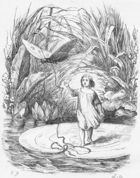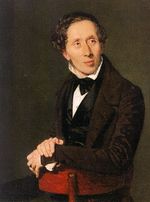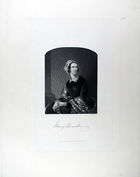Thumbelina
| "Thumbelina" | |
|---|---|
| Author | Hans Christian Andersen (2 April 1805 – 4 August 1875) |
| Original title | "Tommelise" |
| Translator | Mary Howitt |
| Country | Denmark |
| Language | Danish |
| Genre(s) | Literary fairy tale |
| Published in | Fairy Tales Told for Children. First Collection. Second Booklet. 1835. (Eventyr, fortalte for Børn. Første Samling. Andet Hefte. 1835.) |
| Publication type | Fairy tale collection |
| Publisher | C. A. Reitzel |
| Media type | |
| Publication date | 16 December 1835 |
| Published in English | 1846 |
| Preceded by | "Little Ida's Flowers" |
| Followed by | "The Naughty Boy" |
"Thumbelina" (Danish: Tommelise) is a literary fairy tale by Hans Christian Andersen about a thumb-sized girl and her many adventures before falling in love with a flower-fairy prince just her size. "Thumbelina" is mainly Andersen's invention, although he did take inspiration from tales of miniature people such as "Tom Thumb". The tale was first published by C. A. Reitzel on 16 December 1835 in Copenhagen, Denmark with "The Naughty Boy" and "The Traveling Companion" in the second installment of Fairy Tales Told for Children. Andersen published seven fairy tales in 1835 which were not well received by the Danish critics who disliked their informal style and their lack of morals. One critic however applauded "Thumbelina". The earliest English translation of "Thumbelina" is dated 1846. The tale has been adapted to various media including song and animated film.
Contents |
Background
Hans Christian Andersen was born in Odense, Denmark on 2 April 1805 to Hans Andersen, a twenty-two-year-old shoemaker, and his thirty-year-old wife, Anne Marie Andersdatter.[1] An only and a spoiled child who did not play with other boys, Andersen shared a love of literature with his father who read him The Arabian Nights and the fables of Jean de la Fontaine. Together, they constructed panoramas, pop-up pictures, and toy theatres, and took long jaunts into the countryside about Odense.[2]
Andersen's father died in 1816, disappointed with the lack of opportunity to better himself educationally and materially in rural, superstitious Odense, and was buried in a pauper's grave.[3] From then on, Andersen was left to his own devices and played with his theatre, dolls, and read plays. In order to escape his poor, illiterate mother, he began cultivating his artistic inclinations and courting the cultured middle class of Odense, singing and reciting in their drawing-rooms. On 4 September 1819, the fourteen-year-old Andersen, left Odense for Copenhagen with the few savings he had acquired from his performances, a letter of reference to the ballerina Madame Schall, and youthful dreams and intentions of becoming a poet or an actor.[4]
After three years of many rejections and disappointments, he finally found a patron in Jonas Collin, the director of the Royal Theatre, who, believing in the boy's potential, secured funds from the king to send Andersen to a grammar school in Slagelse, a provincial town in west Zealand, with the expectation that the boy would continue his education at Copenhagen University at the appropriate time.
At Slagelse, the seventeen-year-old Andersen joined a junior class of eleven-year-old boys under the tutelage of Simon Meisling, a thirty-five-year-old renowned classicist and translator of Virgil's Aeneid. Short, stout, bald, unkempt, Meisling worked out his frustrations on his pupils and staff. Andersen was a poor Latin student and became the butt of Meisling's scorn,[5] with the teacher telling him, "You're a stupid boy who will never make it."[6] Meisling is believed to be the model for the learned mole in "Thumbelina".[7]
Plot

When the story opens, an old woman longing for a child receives a magic barley seed from a witch. Once planted, a tiny girl emerges from its flower and is named Thumbelina (or in at least one translation, "Thumbelisa"). One night, Thumbelina is asleep in her walnut-shell cradle and is carried off by a toad who wants the miniature maiden as a bride for her son. With the help of friendly fish and a butterfly, Thumbelina escapes the toad and her son, and drifts on a lily pad until captured by a beetle (a may bug). The insect discards her when his friends reject her company. Thumbelina tries to protect herself from the elements, but when winter comes, she is in desperate straits. She is finally given shelter by an old field mouse and tends the mouse's dwelling in gratitude. The mouse suggests Thumbelina marry their neighbor, a mole, but Thumbelina finds the prospect of being married to such a creature repulsive. She escapes the situation by fleeing to a far land with a swallow she nursed back to health during the winter. In a sunny field of flowers, Thumbelina meets a tiny flower-fairy prince just her size and to her liking, and they wed. She receives a pair of wings to accompany her husband on his travels from flower to flower, and a new name, Maia.[8]
Sources and inspiration
“Thumbelina” is essentially Andersen’s invention but takes inspiration from the traditional tale of "Tom Thumb" (both tales begin with a childless woman consulting a supernatural being about acquiring a child). Other inspirations were the six-inch Lilliputians in Jonathan Swift’s Gulliver's Travels, Voltaire‘s short story, “Micromégas“ with its cast of huge and miniature peoples, and E. T. A. Hoffmann’s hallucinatory, erotic tale "Meister Floh" in which a tiny lady a span in height torments the hero. A tiny girl figures in Andersen‘s prose fantasy "A Journey on Foot from Holmen's Canal to the East Point of Amager" (1828),[7][9] and a literary image similar to Andersen’s tiny being inside a flower is found in E. T. A. Hoffmann’s "Princess Brambilla” (1821).[10]
Publication and critical reception

Andersen published two installments of his first collection of Fairy Tales Told for Children in 1835, the first in May and the second in December. "Thumbelina" was first published in the second installment by C. A. Reitzel on 16 December 1835 in Copenhagen, Denmark. "Thumbelina" was the first tale in the booklet which included two other tales: "The Naughty Boy" and "The Traveling Companion". The story was republished in collected editions of Andersen's works in 1850 and then 1862.[11]
The first reviews of the seven tales of 1835 did not appear until 1836 and the Danish critics were not enthusiastic. The informal, chatty style of the tales and their lack of morals were considered inappropriate in children’s literature. One critic however acknowledged "Thumbelina" to be “the most delightful fairy tale you could wish for.”[12]
The critics offered Andersen no further encouragement. One literary journal never mentioned the tales at all while another advised Andersen not to waste his time writing fairy tales. One critic stated that Andersen "lacked the usual form of that kind of poetry [...] and would not study models". Andersen felt he was working against their preconceived notions, and returned to novel-writing, believing it was his true calling.[13] The critical reaction to the 1835 tales was so harsh that he waited an entire year before publishing "The Little Mermaid" and "The Emperor's New Clothes" in the third and final installment of Fairy Tales Told for Children.
English translations

Mary Howitt was the first to translate "Thumbelina" into English and published it as "Tommelise" in Wonderful Stories for Children in 1846. However, she did not approve of the superstitious consultation with the witch in the opening scene and, instead, had the childless woman provide bread and milk to a hungry beggar woman who then rewarded her hostess with a magic barleycorn.
Charles Boner also translated the tale in 1846 and gave the heroine the name 'Little Ellie' while Madame de Chatelain dubbed the child 'Little Totty' in her 1852 translation. The editor of The Child's Own Book (1853) called the child throughout, 'Little Maja', the name she usually receives at the end of the tale from the fairy prince. H.W. Dulcken was probably the translator responsible for the name, 'Thumbelina'. His widely published volumes of Andersen's tales appeared in 1864 and 1866.[14] Mrs. H.B. Paulli translated the name as 'Little Tiny' in the late-nineteenth century.[15]
In the twentieth century, Erik Christian Haugaard translated the name as 'Inchelina' in 1974,[16] and Jeffrey and Diane Crone Frank translated the name as 'Thumbelisa' in 2005.[17] Distinguished modern English translations of "Thumbelina" are found in the six-volume complete edition of Andersen's tales from the 1940s by Jean Hersholt, and Erik Christian Haugaard’s translation of the complete tales in 1974.[18]
Commentaries
For fairy tale researchers and folklorists Iona and Peter Opie, "Thumbelina" is an adventure story from the feminine point of view with its moral being people are happiest with their own kind.. They point out that Thumbelina is a passive character, the victim of circumstances whereas her male counterpart Tom Thumb (one of the tale’s inspirations) is an active character, makes himself felt, and exerts himself.[14] The tale, they note, has been proposed as a "distant tribute" to Andersen's confidante, Henriette Wulff, the small, frail, hunchbacked daughter of the Danish translator of Shakespeare who loved Andersen as Thumbelina loves the swallow;[14] however, no written evidence exists to support the theory.[7]
Folklorist Maria Tatar sees “Thumbelina” as a runaway bride story and notes that it has been viewed as an allegory about arranged marriages, and a fable about being true to one’s heart that upholds the traditional notion that the love of a prince is to be valued above all else. She points out that in Hindu belief, a thumb-sized being known as the innermost self or soul dwells in the heart of all beings, human or animal, and that the concept may have migrated to European folklore and took form as Tom Thumb and Thumbelina, both of whom seek transfiguration and redemption.. She detects parallels between Andersen’s tale and the Greek myth of Demeter and her daughter, Persephone, and, notwithstanding the pagan associations and allusions in the tale, notes that “Thumbelina“ repeatedly refers to Christ‘s suffering and resurrection, and the Christian concept of salvation.[19]
Andersen biographer Jackie Wullschlager indicates that “Thumbelina” was the first of Andersen's tales to dramatize the sufferings of one who is different, and, as a result of being different, becomes the object of mockery. It was also the first of Andersen's tales to incorporate the swallow as the symbol of the poetic soul and Andersen’s identification with the swallow as a migratory bird whose pattern of life his own traveling days were beginning to resemble.[20]
Roger Sale believes Andersen expressed his feelings of social and sexual inferiority by creating characters who are inferior to their beloveds. The Little Mermaid, for example, has no soul while her human beloved has a soul as his birthright. In “Thumbelina”, Andersen suggests the toad, the beetle, and the mole are Thumbelina’s inferiors and should remain in their places rather than wanting their superior. Sale indicates they are not inferior to Thumbelina but simply different. He suggests that Andersen may have done some damage to the animal world when he colored his animal characters with his own feelings of inferiority.[21]
Jacqueline Banerjee views the tale as a success story. “Not surprisingly,“ she writes, “”Thumbelina“ is now often read as a story of specifically female empowerment.“[22] Susie Stephens believes Thumbelina herself is a grotesque, and observes that “the grotesque in children’s literature is [...] a necessary and beneficial component that enhances the psychological welfare of the young reader“. Children are attracted to the cathartic qualities of the grotesque, she notes.[23] Sidney Rosenblatt in his essay "Thumbelina and the Development of Female Sexuality" believes the tale may be analyzed, from the perspective of Freudian psychoanalysis, as the story of female masturbation. Thumbelina herself, he posits, could symbolize the clitoris, her rose petal coverlet the labia, the white butterfly "the budding genitals", and the mole and the prince the anal and vaginal openings respectively.[24]
Adaptations
Animation
Animated films include the video release of "H.C. Andersens eventyrlige verden: Tommelise" (2005), the Warner Bros. release of the Don Bluth and Gary Goldman -directed Thumbelina (1994), and the Golden Films release of Thumbelina (1993). Oyayubihime is a Japanese version of 1983, and Dyuymovochka, a Russian version of 1964. In 1954, Lotte Reiniger released a 10-minute cinematic adaptation featuring her "silhouette" puppets. The earliest animated version of the tale is a silent, black-and-white release by director Herbert M. Dawley in 1924.[25][26][27][28][29][30][31]
Barbie Thumbelina or Barbie Presents Thumbelina is a 2009 Barbie[32] film directed by Conrad Helten. It is the fifteenth in the series of Barbie animated films, and features the voice of Kelly Sheridan as Barbie. The story title is like Hans Christian Andersen's Thumbelina, but the plot is different.
Live action
On June 11, 1984, a television dramatization of the tale was broadcast as the 12th episode of the anthology series Faerie Tale Theatre. The production starred Carrie Fisher.[33] A Barry Mahon-directed psychedelic version of the tale was filmed in 1970 with Shay Garner in the title role[34] and Glenn Chaika's in 2002.[35]
Music
In 1952, the musical biopic Hans Christian Andersen featured actor Danny Kaye singing Frank Loesser’s “Thumbelina”, a song which is perhaps more familiar than the tale on which it is based.[17] Loesser referred to the song as a “ditty” and said, “I could write that junk any day of the week.” The song was nominated for an Academy Award but lost to “The Ballad of High Noon”.[36]
Footnotes
- ↑ Wullschlager 2002, p. 9
- ↑ Wullschlager 2002, p. 13
- ↑ Wullschlager 2002, p. 25-26
- ↑ Wullschlager 2002, p. 32-33
- ↑ Wullschlager 2002, p. 60-61
- ↑ Frank 2005, p. 77
- ↑ 7.0 7.1 7.2 Frank 2005, p. 76
- ↑ Frank 2005, pp. 64-76
- ↑ Wullschlager 2000, p. 162
- ↑ Frank 2005, p. 75-76
- ↑ "Hans Christian Andersen: Thumbelina". Hans Christian Andersen Center. http://www.andersen.sdu.dk/vaerk/register/info_e.html?vid=10. Retrieved 2009-08-22.
- ↑ Wullschlager 2002, p. 165
- ↑ Andersen 2000, p. 335
- ↑ 14.0 14.1 14.2 Opie 1974, p. 219
- ↑ Eastman, p. 258
- ↑ Haugaard 1983, p. 29
- ↑ 17.0 17.1 Frank 2005, p. 64
- ↑ Classe 2000, p. 42
- ↑ Tatar 2008, pp. 193-194, 205
- ↑ Wullschlager 2000, p. 163
- ↑ Sale 1978, pp. 65-68
- ↑ Banerjee, Jacqueline (2008). "The Power of "Faerie": Hans Christian Andersen as a Children's Writer". The Victorian Web: Literature, History, & Culture in the Age of Victoria. http://www.victorianweb.org/genre/childlit/fairytales3.html. Retrieved 2009-08-22.
- ↑ Stephens, Susie. "The Grotesque in Children’s Literature". http://davidlavery.net/grotesque/The_Grotesque_In/grotesquechildrensliterature.html. Retrieved 2009-08-22.
- ↑ Siegel 1998, pp. 123,126
- ↑ “Tommelise (2005)” at IMDb
- ↑ “Thumbelina (1994)” at IMDb
- ↑ “Thumbelina (1993)” at IMDb
- ↑ “Oyayubihime (1983)” at IMDb
- ↑ “Dyuymovochka (1964)” at IMDb
- ↑ “Thumbelina (1954)” at IMDb
- ↑ “Thumbelina (1924)” at IMDb
- ↑ http://www.amazon.com/Barbie-Presents-Thumbelina/dp/B001O3M370/ref=sr_1_1?ie=UTF8&s=dvd&qid=1255256583&sr=1-1
- ↑ Kulik 2008
- ↑ “Thumbelina (1970)” at IMDb
- ↑ Tatar 194
- ↑ Loesser 2000, pp. 127-128
References
- Andersen, Hans Christian; Erik Christian Haugaard (transl.) (1983) [1974]. The Complete Fairy Tales and Stories. New York, NY: Anchor Books. ISBN 0-385-18951-6.
- Andersen, Hans Christian (2000) [1871]. The Fairy Tale of My Life. New York, NY: Cooper Square Press. ISBN 0-8154-1105-7.
- Classe, O. (ed.) (2000). Encyclopedia of Literary Translation into English; v.2. Chicago, IL: Fitzroy Dearborn Publishers. ISBN 1-884964-36-2.
- Eastman, Mary Huse (ed.). Index to Fairy Tales, Myths and Legends. BiblioLife, LLC.
- Frank, Diane Crone; Jeffrey Frank (2005). The Stories of Hans Christian Andersen. Durham, NC and London, UK: Duke University Press. ISBN 0-8223-3693-6.
- Loesser, Susan (2000) [1993]. A Most Remarkable Fella: Frank Loesser and the Guys and Dolls in his Life: A Portrait by his Daughter. New York, NY: Hal Leonard Corporation. ISBN 0-634-00927-3.
- Opie, Iona; Peter Opie (1974). The Classic Fairy Tales. Oxford, UK: Oxford University Press. ISBN 0-19-211559-6.
- Sale, Roger (1978). Fairy Tales and After: From Snow White to E.B. White. Harvard University Press. ISBN 0-674-29157-3.
- Siegel, Elaine V. (ed.) (1992). Psychoanalytic Perspectives on Women. New York, NY: Brunner/Mazel, Inc.. ISBN 0-87630-655-5.
- Wullschlager, Jackie (2002). Hans Christian Andersen: The Life of a Storyteller. Chicago, IL: The University of Chicago Press. ISBN 0-226-91747-9.
External links
- "Tommelise". Original Danish text
- "Thumbelina". English translation by Jean Hersholt